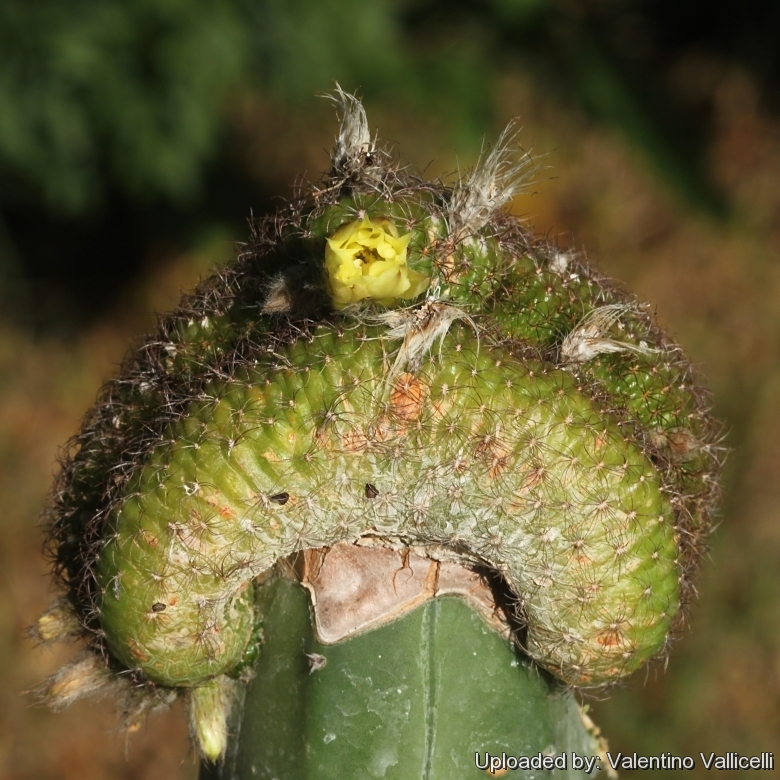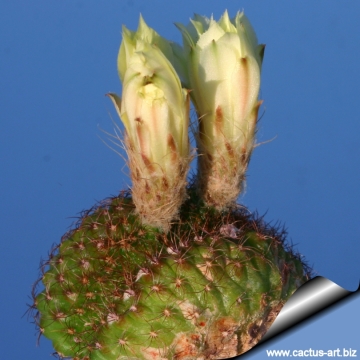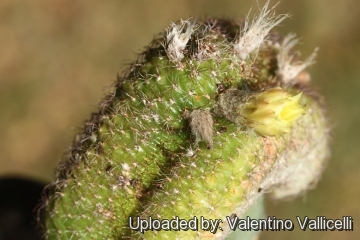Accepted Scientific Name: Frailea schilinzkyana (F.Haage ex K.Schum.) Britton & Rose
Cactaceae (Britton & Rose) 3: 210. 1922 [12 Oct 1922] Britton & Rose

Frailea schilinzkyana f. cristata Photo by: Valentino Vallicelli
Origin and Habitat: Garden origin (Nursery produced cultivar)
Synonyms:
See all synonyms of Frailea schilinzkyana
back
Accepted name in llifle Database:Frailea schilinzkyana (F.Haage ex K.Schum.) Britton & RoseCactaceae (Britton & Rose) 3: 210. 1922 [12 Oct 1922]Synonymy: 26
back
Description: Frailea schilinzkyanaSN|3634]]SN|3634]] is a very small cactus that remains solitary or (occasiaonally) somewhat cespitose. The crested form Frailea schilinzkyanaSN|3634]]SN|3634]] f. cristata is very rare and sought after by collectors, for its unique features.
Root: Has a swollen root below the surface of the compost.
Stem: Fan shaped, diminutive in size, flattened on top, depressed centrally, Medium dark brownish green.
Ribs: Very indistinct and strongly tubercled
Areoles: Placed on the upper side of the tubercles.
Radial spines: About 12 to 14 short (2 to 3 mm long) which vary from yellow to dark tannish-brow n or blackish in colour, more or less appressed and reflexed.
Central spines: Solitary, stouter than the radials.
Roots: Fat central tap root.
Flowers: Yellow small, infundibuliform, often cleistogamous (Even when their flowers do not open, they still form fruits with many seeds)
Blooming season: Flowers will open only in great heat, in the hottest, brightest, afternoon sun, if at all.
Fruits: Dry, indehiscent, that detach easily, yellowish, pericarp membranous, fragile that break easily, releasing the seed.
Subspecies, varieties, forms and cultivars of plants belonging to the Frailea schilinzkyana group
 Frailea friedrichii Buining & Moser: stems solitary, dark green to coppery red, to 3-5 cm in diameter. Ribs 17-20, vertical, and forming tubercles. distribution: Cordillera and Paraguarí, Paraguay.
Frailea friedrichii Buining & Moser: stems solitary, dark green to coppery red, to 3-5 cm in diameter. Ribs 17-20, vertical, and forming tubercles. distribution: Cordillera and Paraguarí, Paraguay. Frailea grahliana (F.Haage) Britton & Rose
Frailea grahliana (F.Haage) Britton & Rose- Frailea grahliana subs. moseriana (Buining & Bredero) Prestlé
- Frailea ignacionensis Buining & G.Moser
 Frailea perumbilicata F.Ritter: has stems typically flattened and umbilicate above. Ribs usually 15. Radial spines 6-10, central spines usually absent. Distribution: Rio Grande do Sul, Brazil.
Frailea perumbilicata F.Ritter: has stems typically flattened and umbilicate above. Ribs usually 15. Radial spines 6-10, central spines usually absent. Distribution: Rio Grande do Sul, Brazil. Frailea schilinzkyana (F.Haage ex K.Schum.) Britton & Rose: has small stems (ca 3 cm Ø) depressed globular dark brownish green. Ribs 10-13 tubercled. Spines 12 to 14, yellow to dark tannish-brown 2 to 3 mm long. Distribution: Brazil), Argentina, Paraguay and Uruguay.
Frailea schilinzkyana (F.Haage ex K.Schum.) Britton & Rose: has small stems (ca 3 cm Ø) depressed globular dark brownish green. Ribs 10-13 tubercled. Spines 12 to 14, yellow to dark tannish-brown 2 to 3 mm long. Distribution: Brazil), Argentina, Paraguay and Uruguay. Frailea schilinzkyana f. cristata hort.: Crested form.
Frailea schilinzkyana f. cristata hort.: Crested form. Frailea ybatensis Buining & Moser: has less numerous spines, more numerous ribs, dark brownish-green or purple-violet stems, and citron yellow flowers. Distribution: Ytá-Ybaté, South East of Asunción, Paraguay.
Frailea ybatensis Buining & Moser: has less numerous spines, more numerous ribs, dark brownish-green or purple-violet stems, and citron yellow flowers. Distribution: Ytá-Ybaté, South East of Asunción, Paraguay.
Bibliography: Major references and further lectures
1) James Cullen, Sabina G. Knees, H. Suzanne Cubey “The European Garden Flora Flowering Plants: A Manual for the Identification of Plants Cultivated in Europe, Both Out-of-Doors and Under Glass” Cambridge University Press, 11/Aug./2011
2) David Hunt, Nigel Taylor “The New Cactus Lexicon” DH Books, 2006
3) Edward F. Anderson “The Cactus Family” Timber Press, 2001
 Frailea schilinzkyana f. cristata Photo by: Cactus Art
Frailea schilinzkyana f. cristata Photo by: Cactus Art Frailea schilinzkyana f. cristata Photo by: Valentino Vallicelli
Frailea schilinzkyana f. cristata Photo by: Valentino Vallicelli Frailea schilinzkyana f. cristata Photo by: Valentino Vallicelli
Frailea schilinzkyana f. cristata Photo by: Valentino VallicelliSend a photo of this plant.The gallery now contains thousands of pictures, however it is possible to do even more. We are, of course, seeking photos of species not yet shown in the gallery but not only that, we are also looking for better pictures than those already present.
Read More... Cultivation and Propagation: It is not too difficult in a greenhouse, although grows quite slowly. It is usually seen as a grafted plant but grows on its own roots too.
Soil: Use mineral well permeable mineral soil with little organic matter (peat, humus).
Exposure: They need a good amount of light shade to full sun this help to keep the plants healthy, although slow growth.
Watering: Water sparingly from March till October (weekly during summertime, if the weather is sunny enough), with a little fertilizer added. Less or no water during cold winter months, or when night temperatures remain below 10° to prevent root loss. It is sensitive to overwatering (rot prone).
Fertilization: Feeding may not be necessary at all if the compost is fresh then, feed in summer only if the plant hasn't been repotted recently. Do not feed the plants from September onwards as this can cause lush growth which can be fatal during the darker cold months.
Hardiness: Keep perfectly dry in winter at temperatures from 5 to 15 degrees centigrade. (but it is relatively cold resistant and hardy to 0° C, or possibly colder for short periods) In the rest period no high atmospheric humidity!!
Crested growth: Unlike 'monstrose' varieties of plants, where the variation from normal growth is due to genetic mutation, crested growth can occur on normal plants. Sometimes it's due to variances in light intensity, or damage, but generally the causes are unknown. A crested plant may have some areas growing normally, and a cresting plant that looks like a brain, may revert to normal growth for no apparent reason. If you have any of the crested part left you need to remove the normal growth and leave the crested part behind this will need to be done regularly.
Propagation: Grafting or cuttings. Plants are usually grafted onto column-shaped cacti but proved to be able to produce their own roots if degrafted. Cuttings will take root in a minimum temperature of 20° C (but better in hot weather). Cuttings of healthy shoots can be taken in the spring and summer. Cut the stem with a sharp, sterile knife, leave the cutting in a warm, dry place for a week or weeks (depending on how thick the cutting is) until a callus forms over the wound. Once the callus forms, the cutting may be inserted in a container filled with firmed cactus potting mix topped with a surface layer of coarse grit. They should be placed in the coarse grit only; this prevents the cut end from becoming too wet and allows the roots to penetrate the rich compost underneath. The cuttings should root in 2 to 6 weeks. Large crested piece must be placed on the soil surface without burying the plant base down in the soil.













